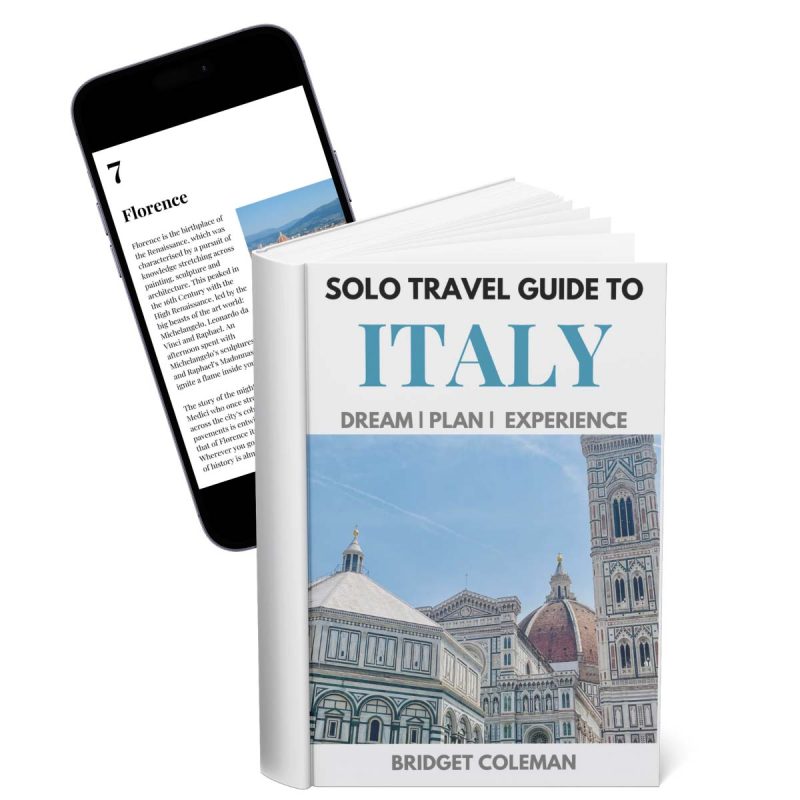Some places are worth a return visit. Orvieto is one of those places.
Although my Italian friends took me to Orvieto on a day trip from Rome some years ago, I was itching to see more of this charming Umbrian hill town. Perched on a pedestal of tufa rock more than 1,000 feet above a valley carved by the winding Paglia River, its medieval cobbled streets and artistic and historic treasures are a joy to explore.
But what are the best things to do in Orvieto?
Make the most of your visit with my lovingly crafted Orvieto guide that includes its must-see attractions, from its magnificent cathedral to enduring reminders of its Etruscan roots.
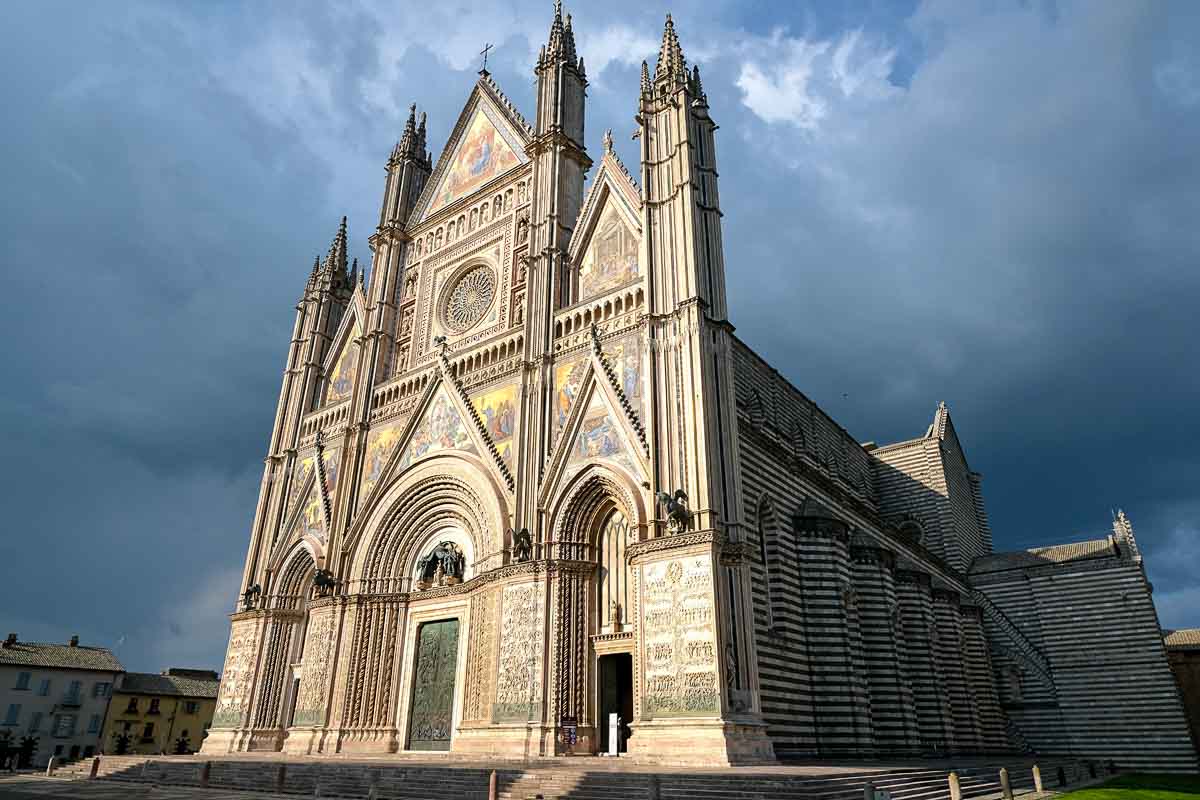
Some articles on this website contain affiliate links. This means that I may earn a small commission if you make a purchase through these links. As an Amazon Associate, I earn from qualifying purchases. Read the full disclosure here.
What is Orvieto Known for?
Orvieto is mostly known for “the three Cs”: its majestic cathedral, delicious Classico wine and ceramics. As a major Etruscan town, it also has a rich and long history.
The Etruscans were a pre-Roman tribe who controlled central Italy until the 4th Century BC. Orvieto was a major town, known as Velzna, before it was destroyed by the Romans following a two-year siege.
Orvieto lay abandoned for six centuries before being rebuilt, becoming a city-state in the Middle Ages.
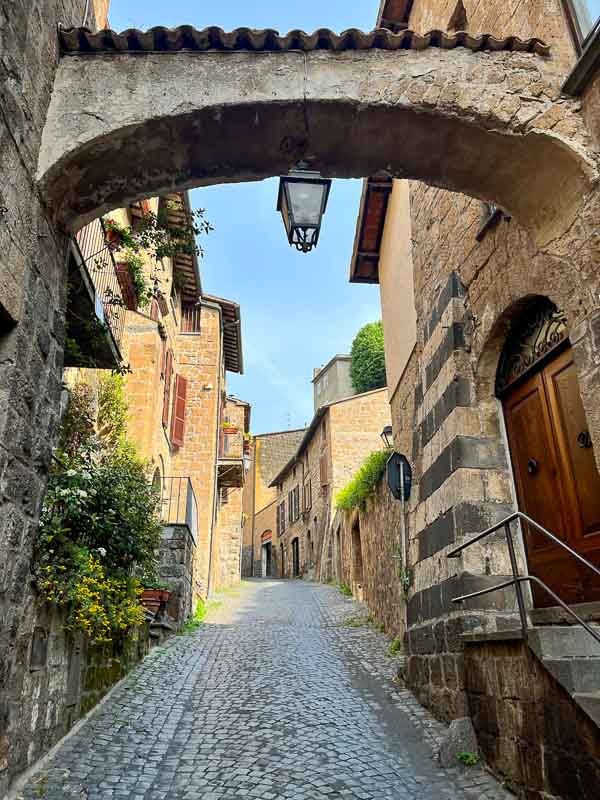
I’VE WRITTEN THIS ITALY SOLO TRAVEL GUIDE!
A 100+ page ebook to inspire and equip solo travellers with the confidence and knowledge to explore Italy independently
- Plan Your Trip – with curated itineraries, budgeting and how to get around
- Explore Awesome Destinations – guides to the must-see cities of Rome, Florence, Venice and Naples
- Stay Safe as a Solo Traveller – practical safety advice, empowering you to confidently navigate Italy and avoid common pitfalls
- Enjoy Eating Out in Italy – essential tried-and-tested solo dining tips
Best Things to Do in Orvieto, Italy (+ Map)
Orvieto provides one of the best sightseeing experiences in Italy.
Everywhere you turn there are honey-coloured stone buildings, flowerpots bursting with blooms and narrow alleys that beg to be explored. It’s a photographer’s dream.
While it is tempting to simply wander its narrow streets, stopping for a coffee or glass of Orvieto Classico, you would miss out on some of the best attractions in Umbria.
To help you on your way, here is a map of what to see in Orvieto. For a closer look and interactive map, simply click here or on the image.
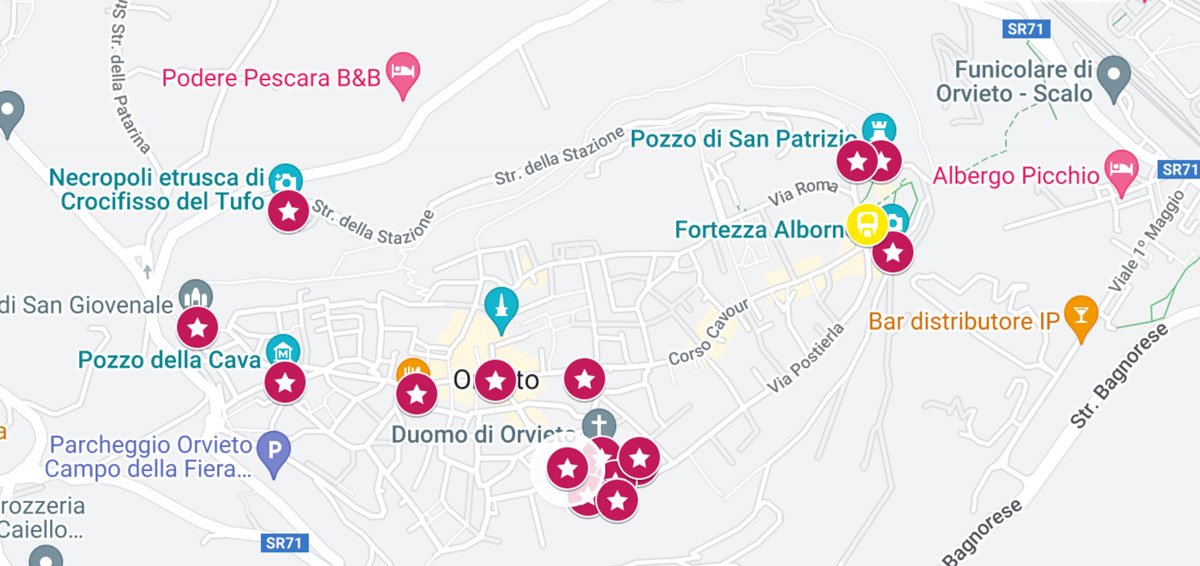
1. Orvieto Cathedral (Duomo di Orvieto)
Orvieto’s show-stopping cathedral will be one of the highlights of your trip to Italy.
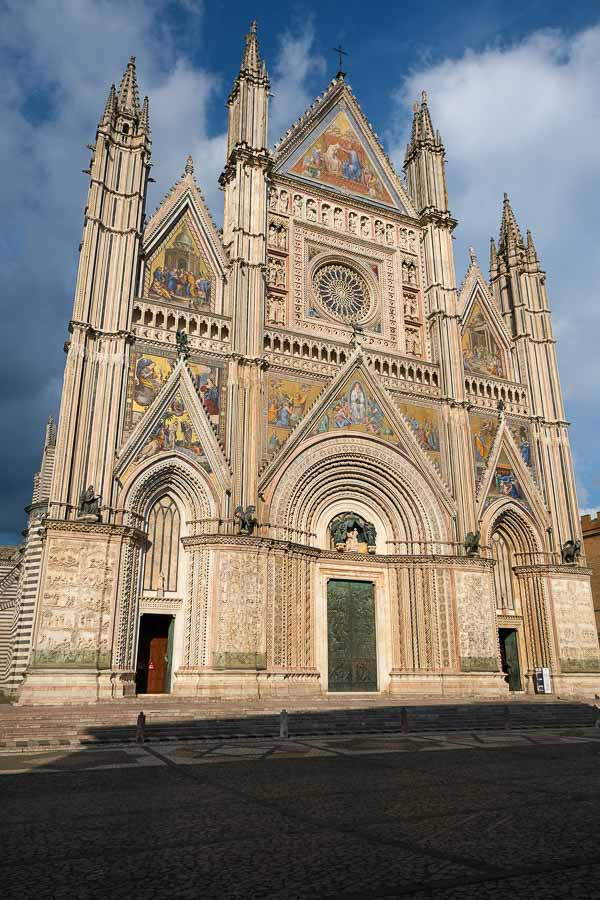
Orvieto Cathedral owes its existence to the Miracle of Bolsena.
In 1263, a German priest, Peter of Prague, stopped to celebrate Mass at Bolsena on his way to Rome. As he did so, blood started to seep from the consecrated Host onto the altar linen.
Father Peter hightailed it to Orvieto to present the linen to Pope Urban IV in Orvieto who proclaimed it a miracle, and the cathedral was built to house this new relic. You have to feel sorry for poor old Bolsena.
With its Technicolor mosaics, elaborate spires and tracery, the Duomo’s sumptuous Gothic façade is one of the finest in the country. The celebrated bas-reliefs on the lower pilasters are a Bible in stone, capturing the Christian story from Creation to the Last Judgement.
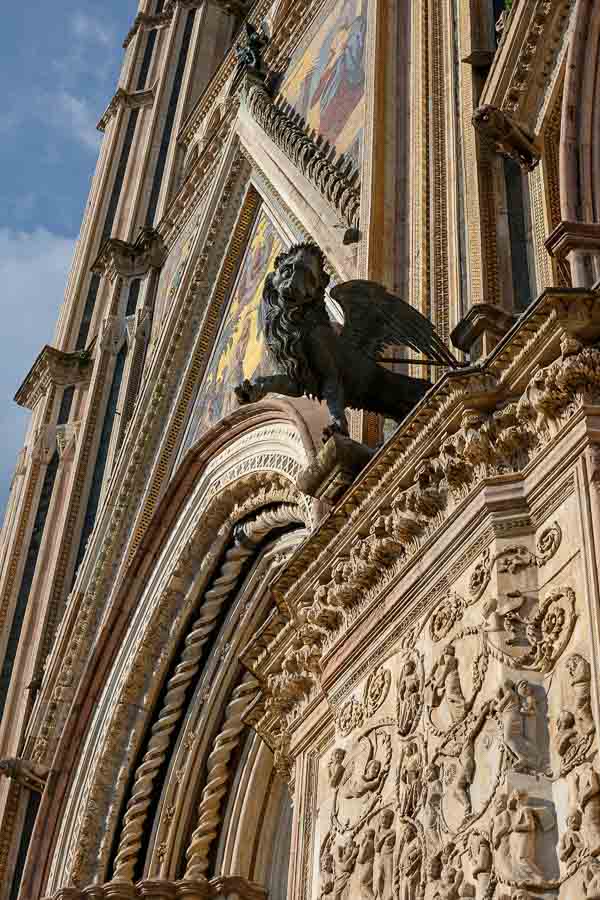
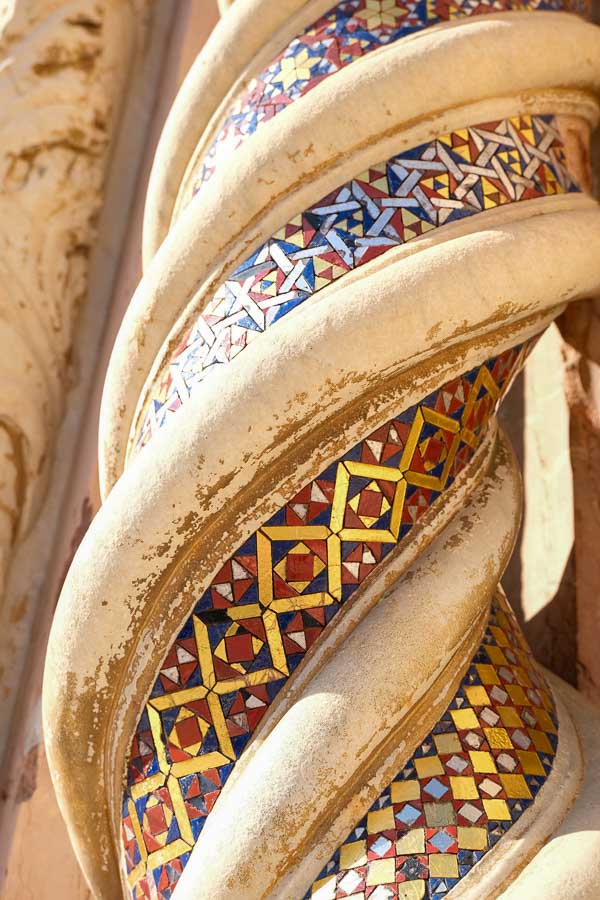
In contrast with this highly decorative exterior, the interior is more low-key, its zebra-striped stonework dimly lit with light filtered through alabaster windows.
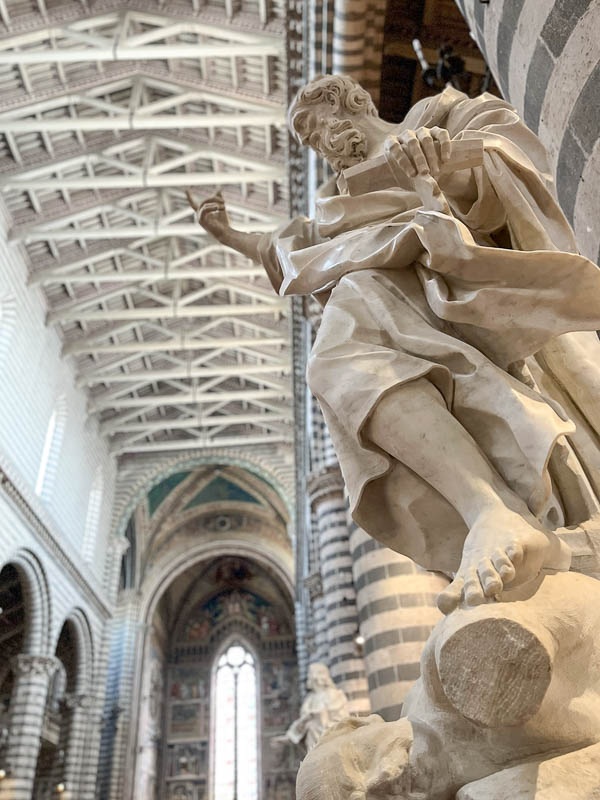
The bloody cloth is in the Chapel of the Corporal. You enter this through a separate door and it is reserved for private prayer only.
Orvieto Cathedral’s most remarkable artistic treasure is the Chapel of San Brizio.
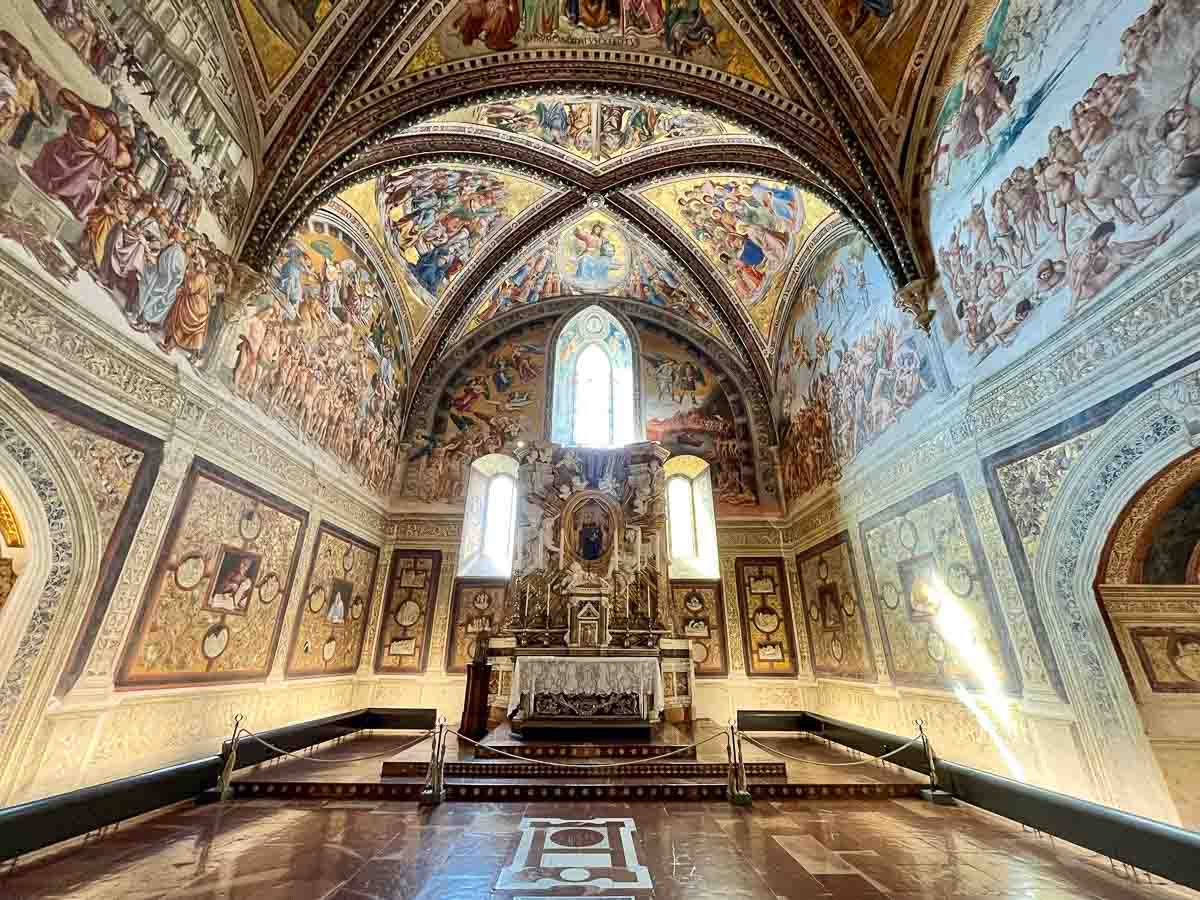
Its brilliantly lit frescoes were started by Fra Angelico in 1477 and completed by Luca Signorelli. The Day of Judgement and Life after Death, painted between 1499 and 1504, are Signorelli’s masterpieces.
2. MoDo Museum (Museo dell’Opera del Duomo)
MoDo Museum is located in two buildings in Orvieto: the Emilio Greco Collection in Palazzo Soliano and the Cathedral Arts Collection behind the Duomo.
Housed in Palazzo Soliano, the Emilio Greco Collection is dedicated to Emilio Greco (1913 – 1995), the Sicilian artist who designed the striking bronze doors of Orvieto Cathedral. This collection displays his sketches and sculptures, many of which are twisting and turning nudes.
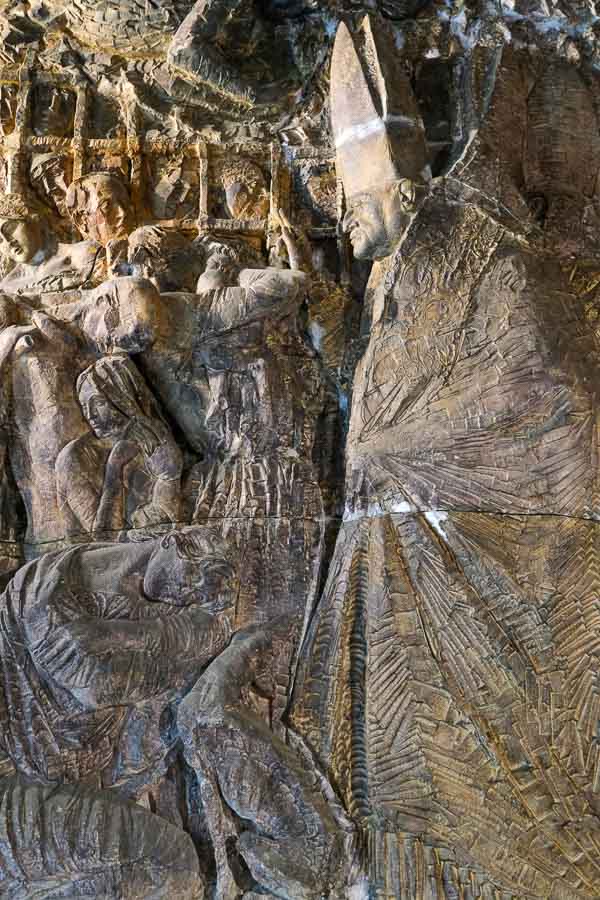
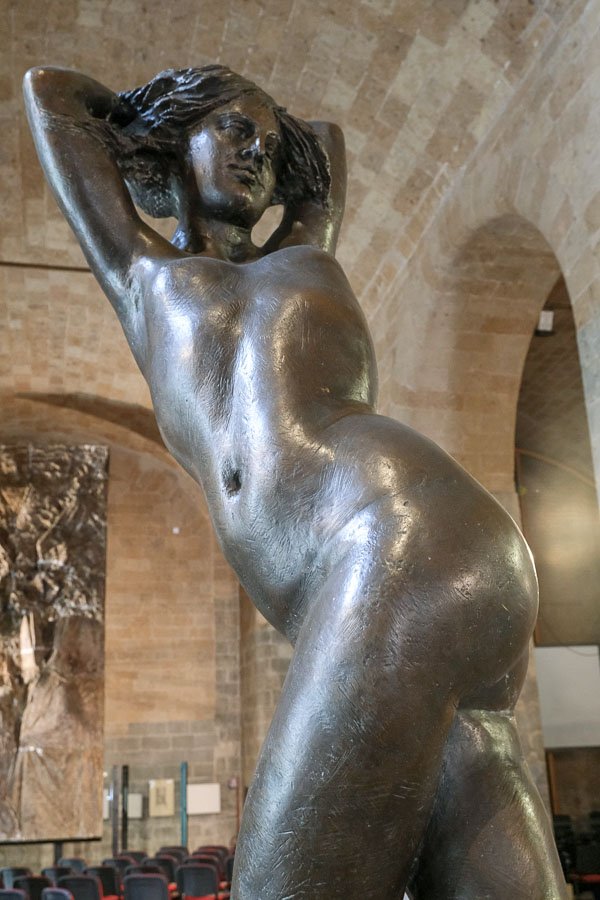
The Cathedral Arts Collection is one for enthusiasts of devotional art. Special mention must be given to a few works by Signorelli, some astonishing mosaics and sublime wooden carvings.
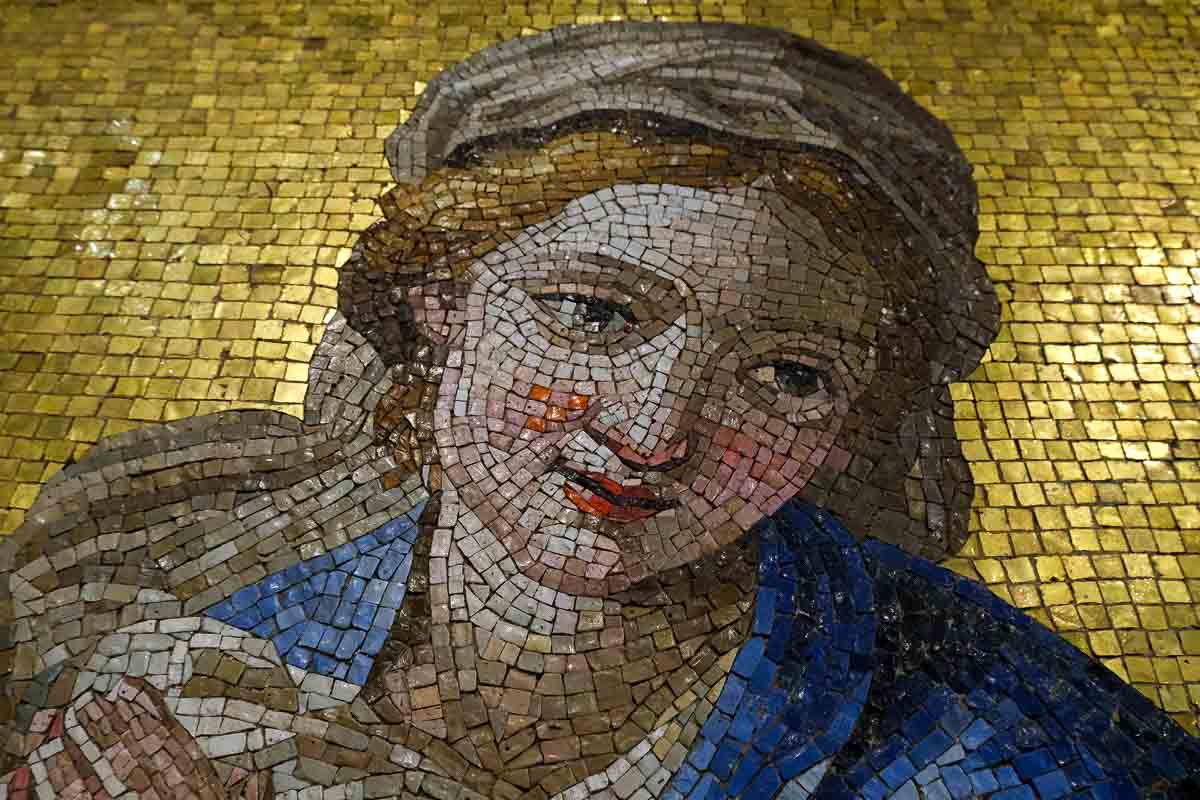
When I visited, information at these two sites was in Italian only.
3. Chiesa San Giovanale
Dating from 1004 and built on the site of an Etruscan temple, Chiesa San Giovanale is the oldest church in Orvieto. Overlooking the Umbrian agricultural landscape, this was the town’s cathedral for the first 300 years of its life.
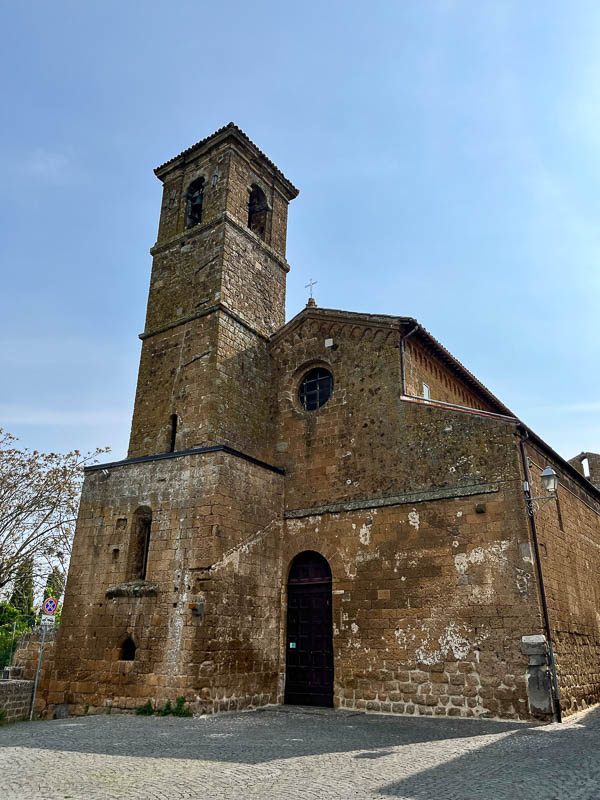
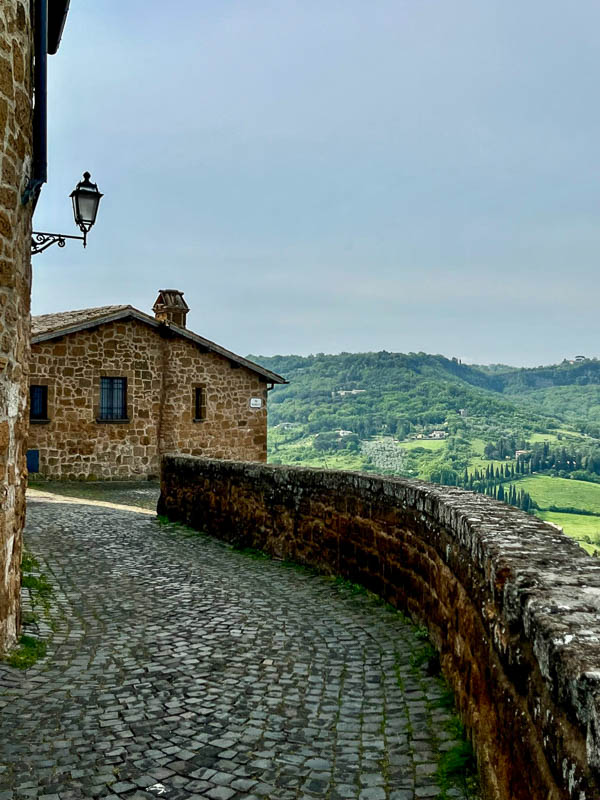
Step inside this Romanesque church and put one euro in the box to take a look at its fresco-laden columns and walls.
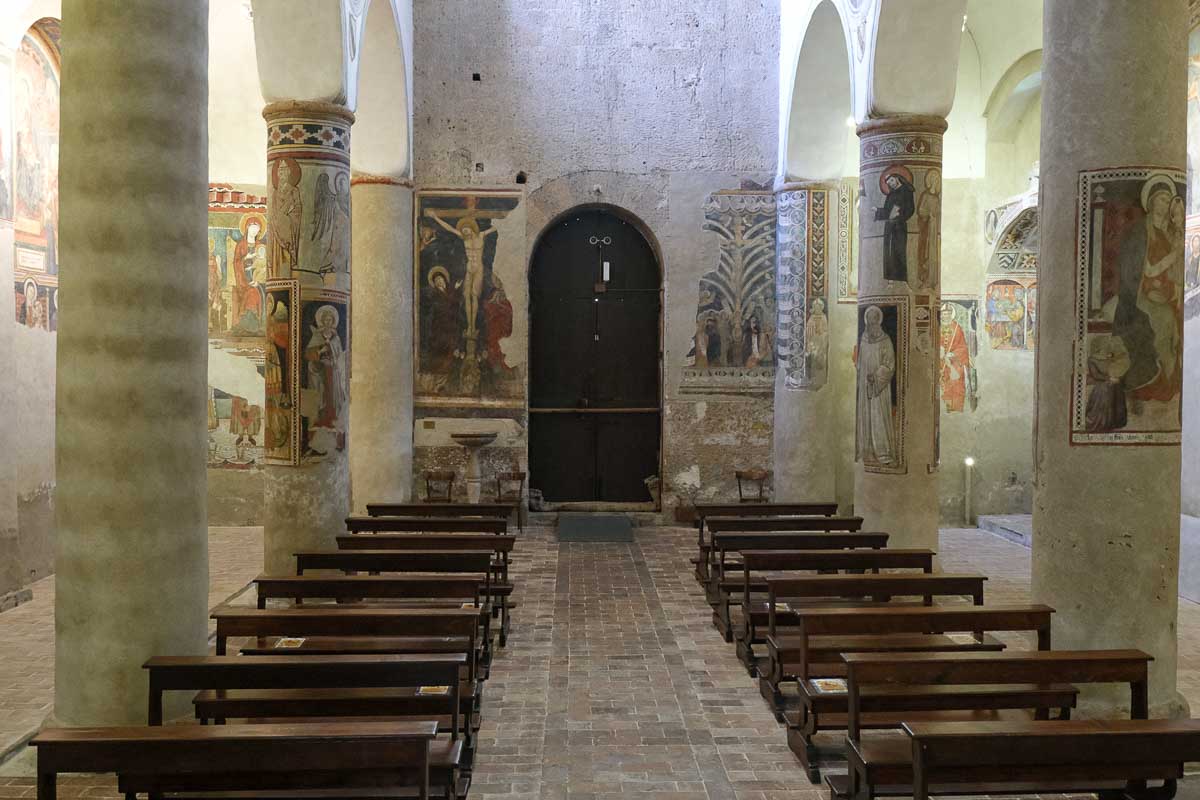
These were badly damaged during the 17th Century when the church’s interior walls were liberally sprinkled with lime to disinfect them after a plague epidemic. However, recent renovation has restored them to their medieval splendour.
Address: Via Volsinia, 05018 Orvieto
4. Church of Sant’Andrea
Occupying the site of former Etruscan and Roman public forums, the Piazza della Repubblica is one of Orvieto’s most important squares. It is home to the City Hall (Palazzo Communale) and the Church of Sant’Andrea.
Dating from the early 1400s, this Romanesque-Gothic style church has a striking dodecagonal bell tower. Its underground crypt is a time capsule of archaeological treasures dating back to the Etruscan age.
Address: Piazza della Repubblica, 05018 Orvieto
Admission fee applies to visit the basement. By guided visit with prior reservation only. More information is here.
5. Orvieto Underground tour
Beneath Orvieto is a second town.
Back in Etruscan times, space was a serious issue. So they dug underground, carving out a network of hand-hewn caves.
Thanks to their 70% humidity, these subterranean spaces were never inhabited but were used for storage and as caves for pigeons, a main source of protein. In later times, they were used as bomb shelters for the 8,000 inhabitants of the Lower Town (the Upper Town was protected by the Nazis).
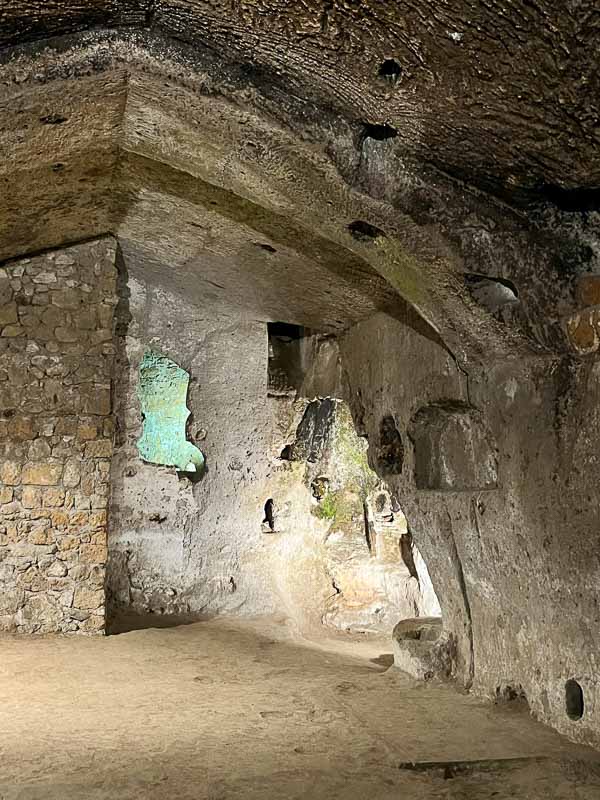
Today, this network of 1,200 caves continues to be used for storage by homes and businesses in Orvieto, particularly as wine cellars.
This excellent guided tour of Orvieto Underground weaves archaeological history with a good old poke around these caverns.
6. St. Patrick’s Well (Pozzo di San Patrizio)
You cannot help but be impressed by this deep well. Built in the 16th Century to guarantee a water supply for Orvieto’s citizens, it is 175 feet deep and 45 feet wide.
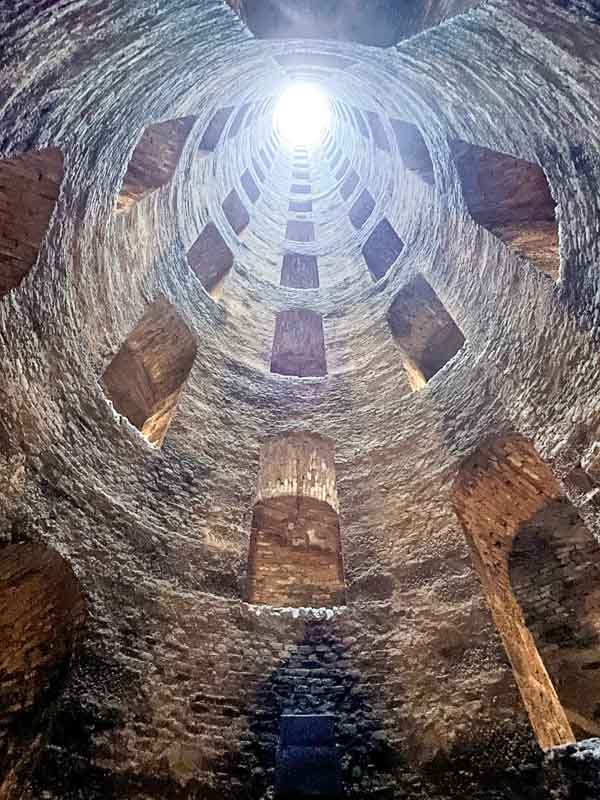
Its double-helix design allowed a safe and efficient one-way traffic flow. At the bottom of St. Patrick’s Well, there is a bridge where people could scoop up water.
A return journey to the bottom of this well takes 20 – 30 minutes, an excellent way to increase your step count for the day. Think of it as a church bell tower climb in reverse.
7. Well of the Quarry (Pozzo della Cava)
Pozzo della Cava offers a third fascinating underground journey through the ancient district of Orvieto.
This family-owned complex of nine caves is stuffed full of Etruscan, Medieval and Renaissance artefacts.
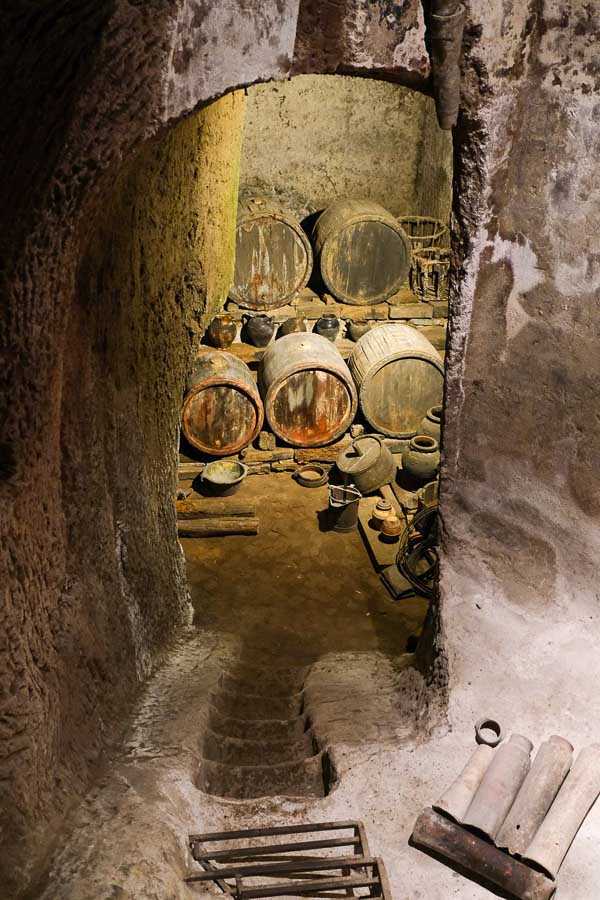
These include the remains of two kilns used in the production of ceramics. There is an Etruscan rock necropolis and cistern, a tomb-turned-clay-store and Medieval rubbish pits.
But perhaps the star of this particular show is the Pozzo della Cava itself. This beautifully carved Etruscan well was discovered and expanded between 1527 and 1530.
8. National Archaeological Museum (Museo Archeologico Nazionale di Orvieto)
This treasure trove of ancient goodies from various excavations around town is one of the best things to see in Orvieto if you are interested in its Etruscan roots.
The National Archaeological Museum’s small but perfectly formed collection does an excellent job of presenting information about Orvieto’s archaeological sites and displays well-preserved Etruscan bronzes, ceramics and terracotta objects. Don’t miss the Golini Tombs, reconstructed 4th Century BC tombs, richly decorated with scenes from an Etruscan banquet in the afterlife.
There are also figureheads from above the lintel of the Temple of Belvedere, still bearing traces of paint, and the exquisite Heads of Divinity, some of the terracotta objects found in a well in Via San Leonardo.
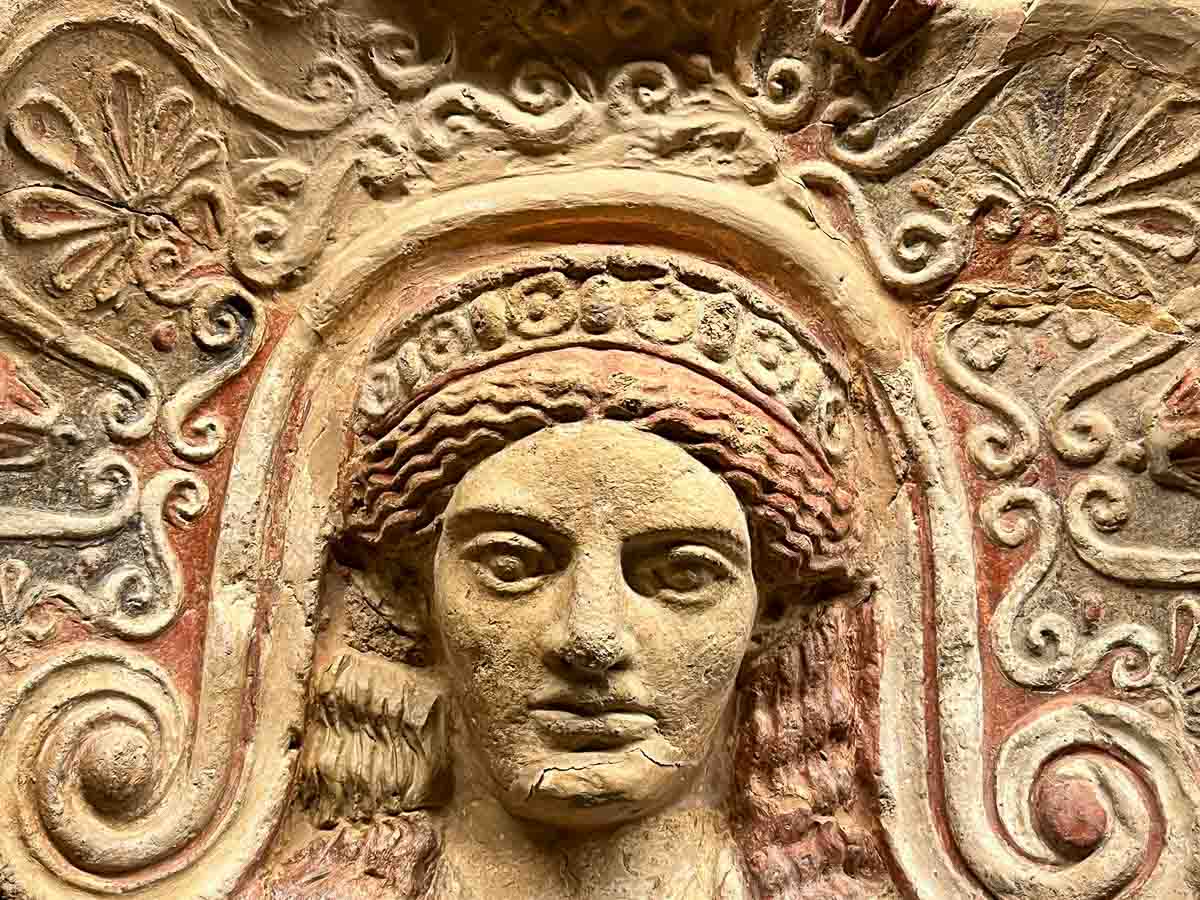
9. Claudio Faina Museum (Museo Claudio Faina)
Housed in a former nobleman’s neoclassical mansion facing the cathedral, the Claudio Faina Museum holds an extensive collection of sculptures, coins and jewellery.
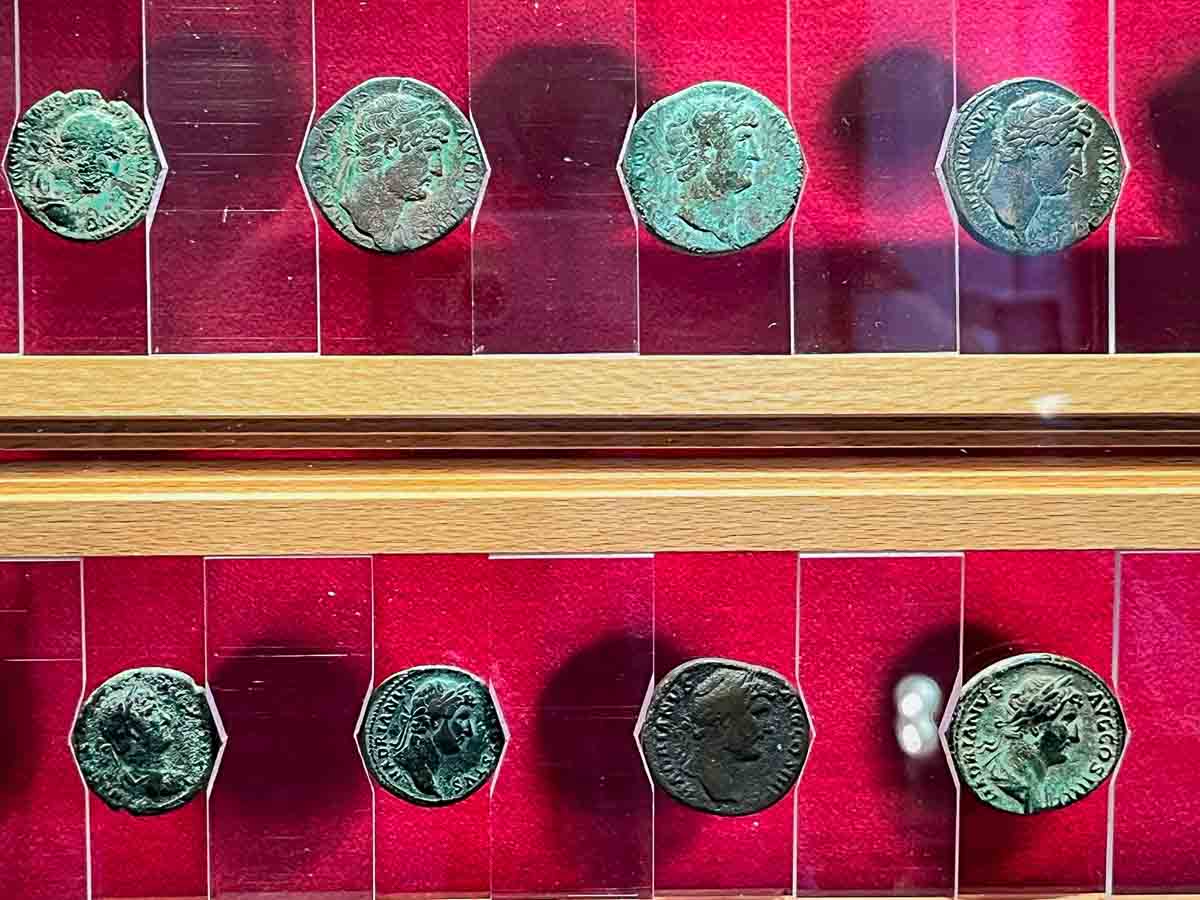
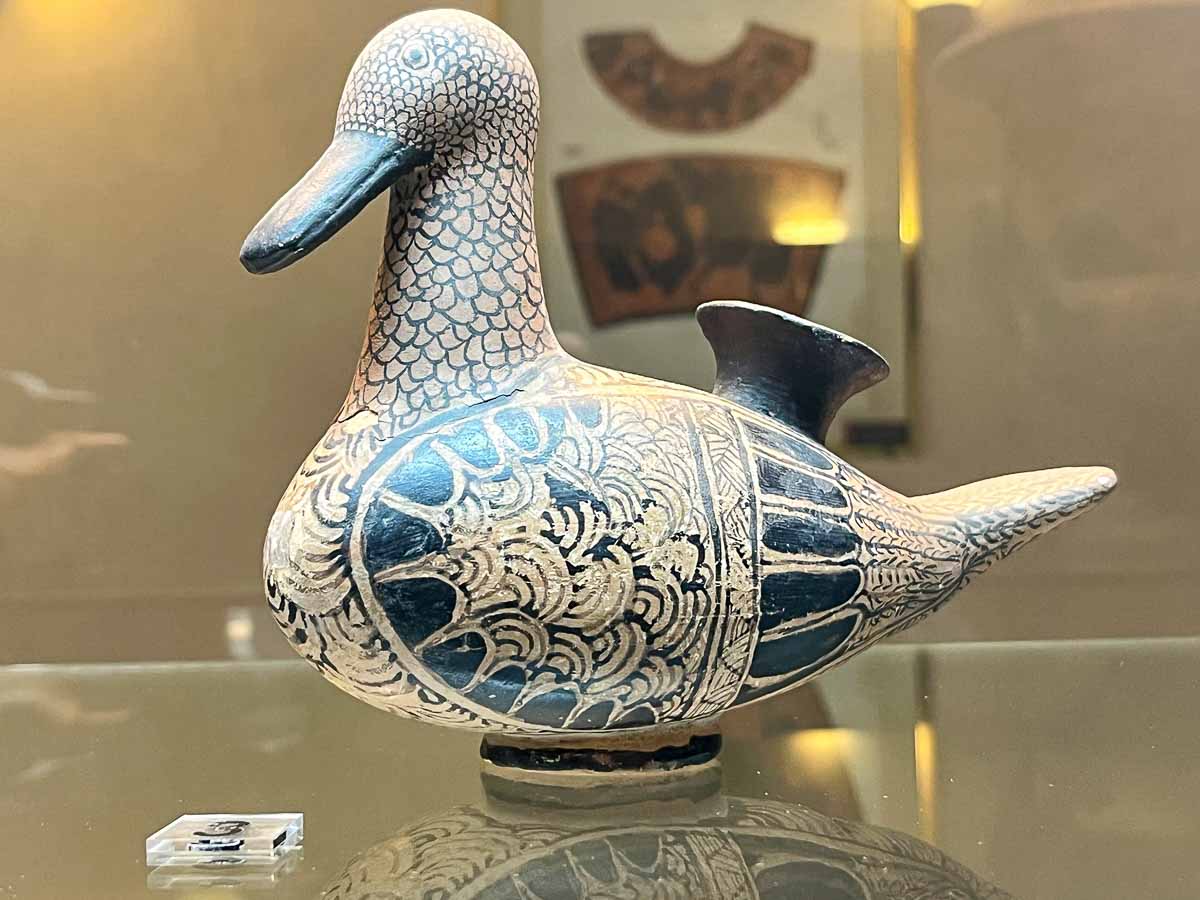
After the unification of Italy in 1861, the tombs of the Crocifisso del Tufo necropolis became an archaeological free-for-all and a rich source of much of the Etruscan loot in this fine museum.
Address: Piazza del Duomo, 05018 Orvieto. Check the opening hours here.
10. Etruscan Necropolis (Crocifisso del Tufo)
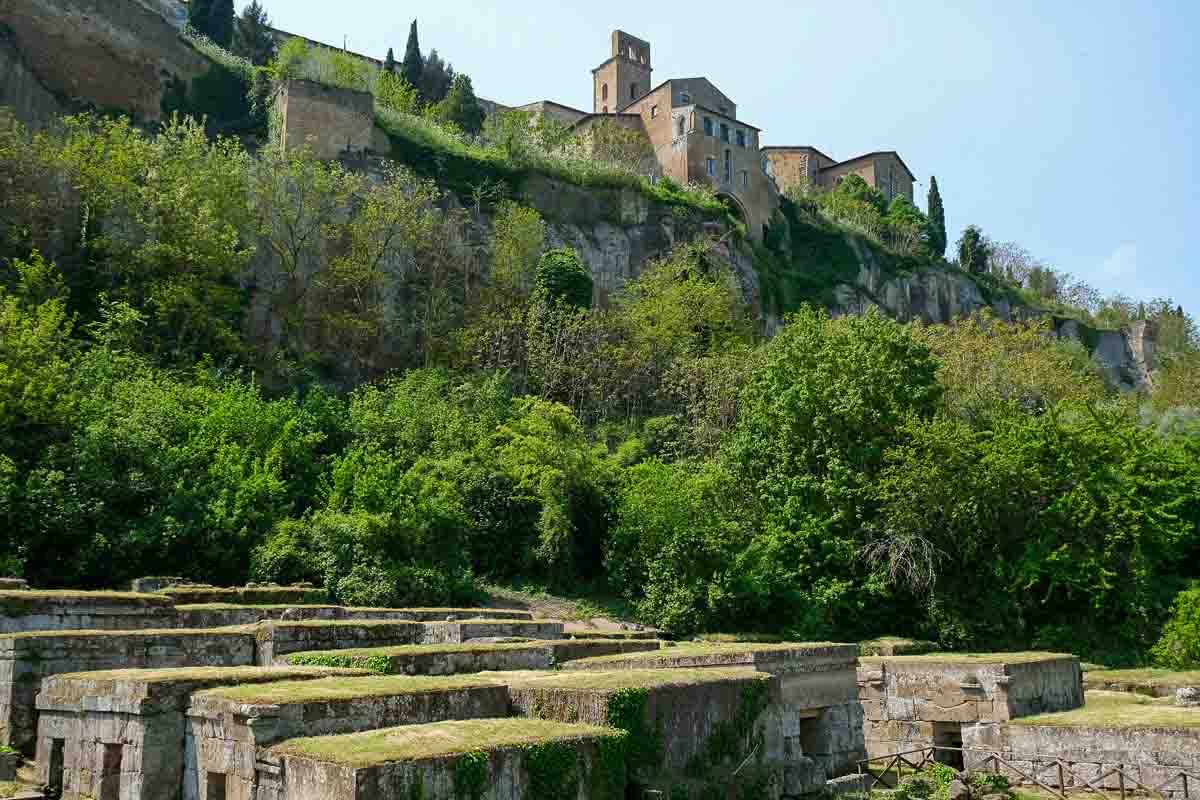
Orvieto’s Etruscan necropolis lies at the base on which the town. This remarkable “city of the dead” owes its name – Crocifisso del Tufo – to the 16th-century crucifix sculpted from tufa and housed in a small chapel above the cemetery.
The necropolis is a fascinating place to explore, albeit slightly eerie. It dates from the 6th to the 5th Century BC and is occupied by tombs made with locally quarried tufa.
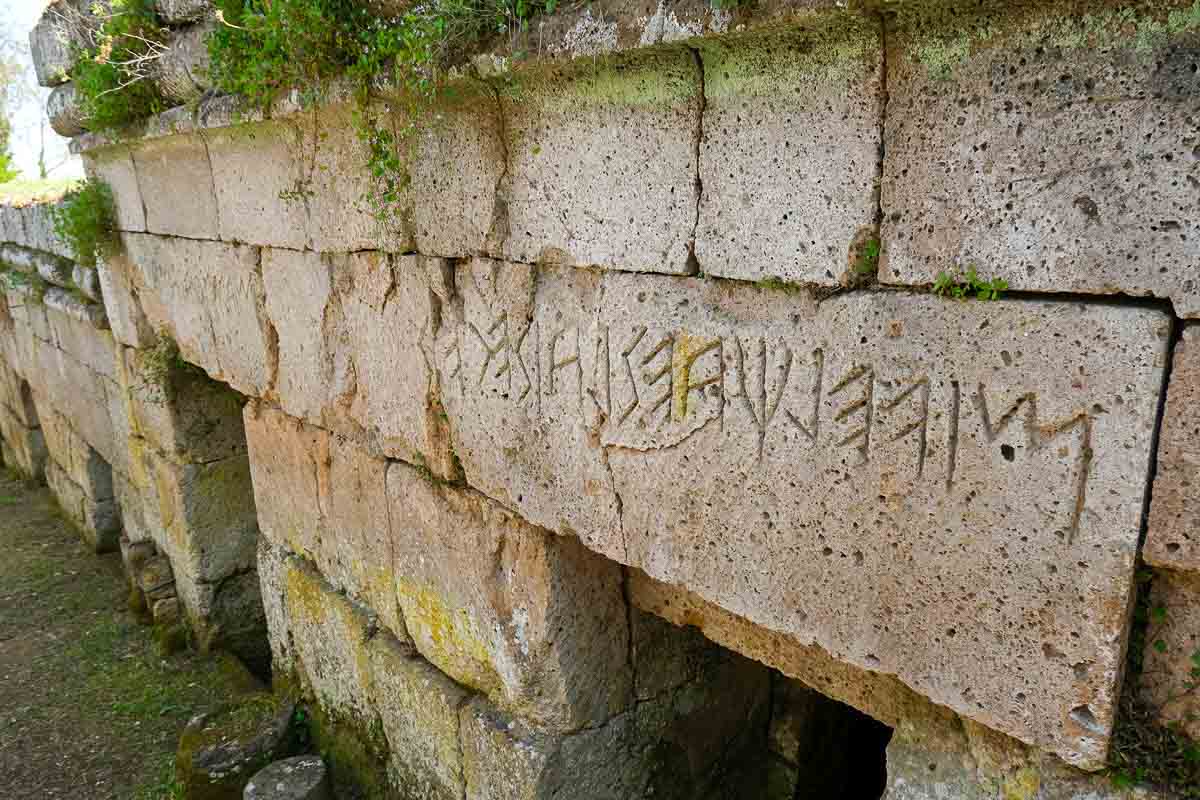
This is one of the things to do in Orvieto that requires the most effort.
To get to the Etruscan Necropolis, exit the town at Porta Vivaria and follow the Anello della Rupe signs. A series of steps will lead you to the necropolis at the base of the cliff.
But this is a lovely walk, passing dazzling yellow dandelions punctuated with splashes of scarlet poppies to the accompaniment of birdsong.
11. Belvedere Temple
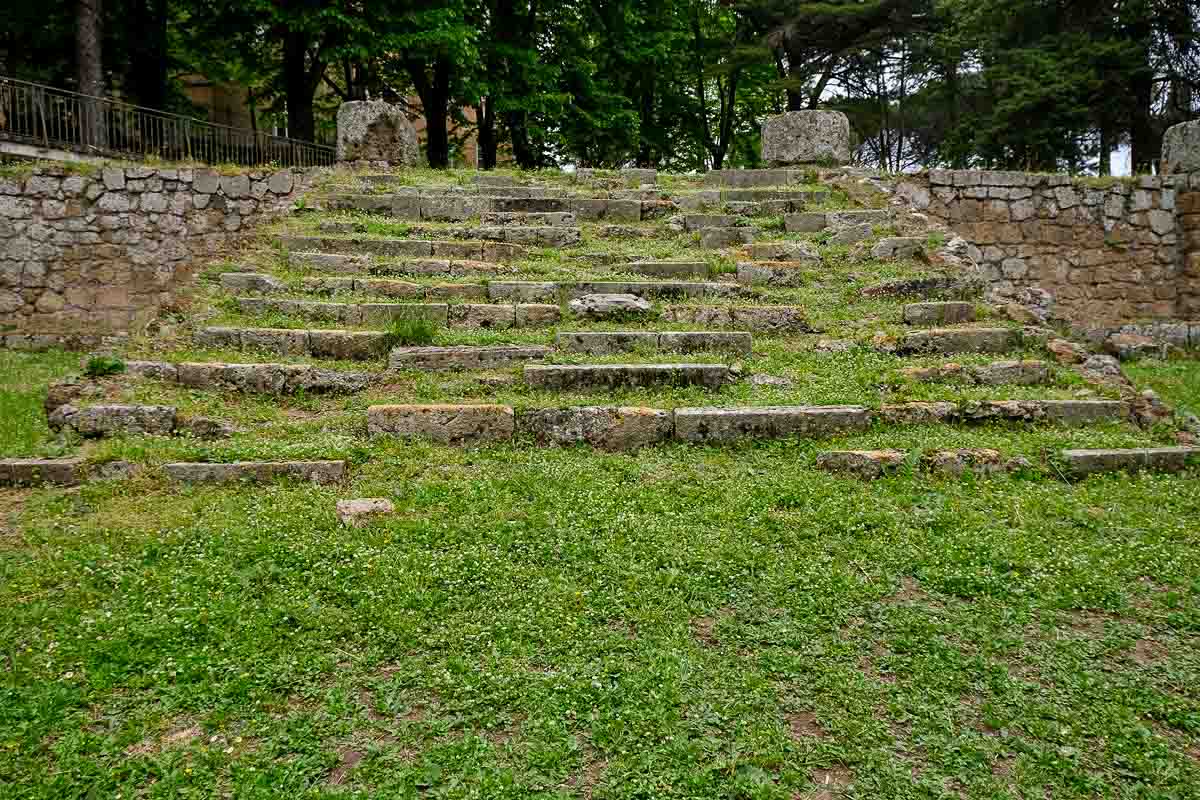
It’s worth taking a look at the Belvedere Temple if you are visiting the adjacent St. Patrick’s Well.
Thought to have been built to honour Tinia, the Jupiter of the Etruscans, the remains of this Etruscan temple are set in a grassy area with trees. You can see some parts of the foundation and the bases of columns but the remainder has been lost to the ravages of time.
Entrance is free.
12. Torre del Moro
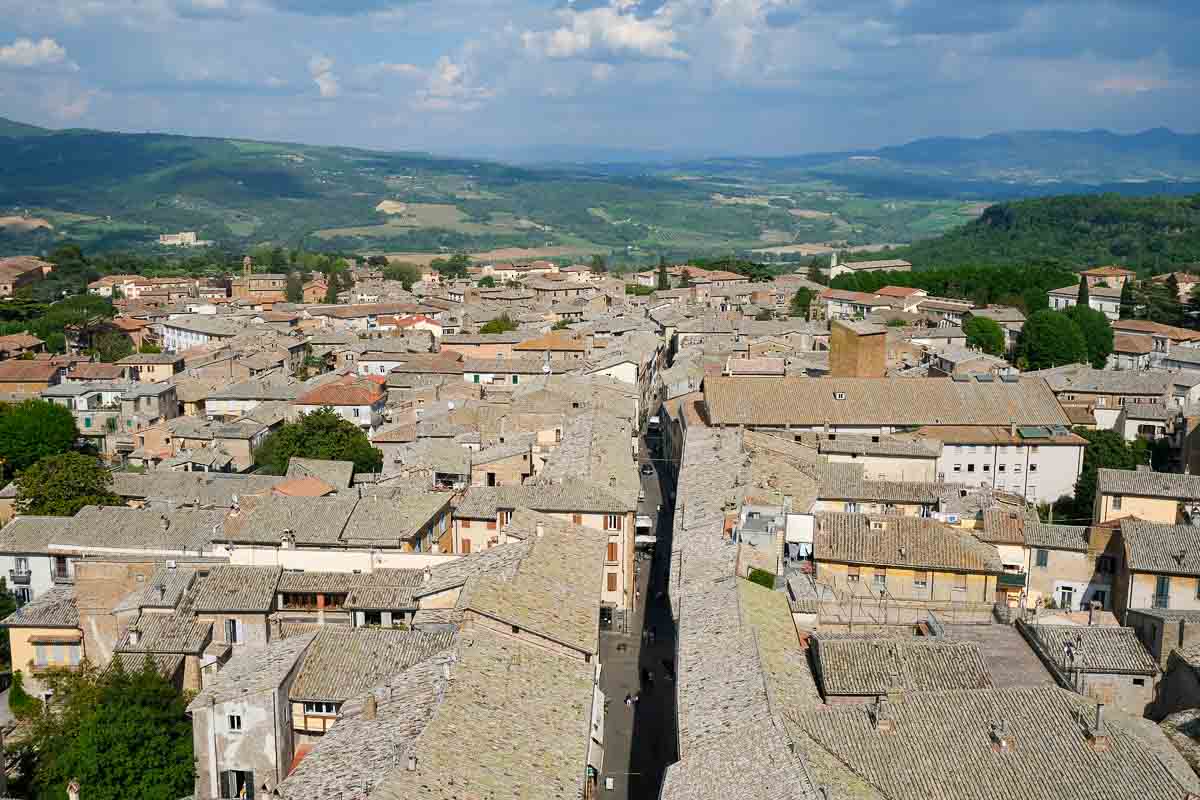
Soaring 47 meters above street level, this clock tower in the centre of town is one of Orvieto’s landmarks.
Named after Raffaele di Sante, known as “il Moro”, Torre del Moro was built at the end of the 13th Century and speaks of the town’s prosperity and power. Its clock was a later addition, dating from 1866.
Climb its 250 steps for 360-degree views of Orvieto and the countryside beyond. You can cut out some of these steps by taking the elevator to the 2nd floor.
13. The Rupe
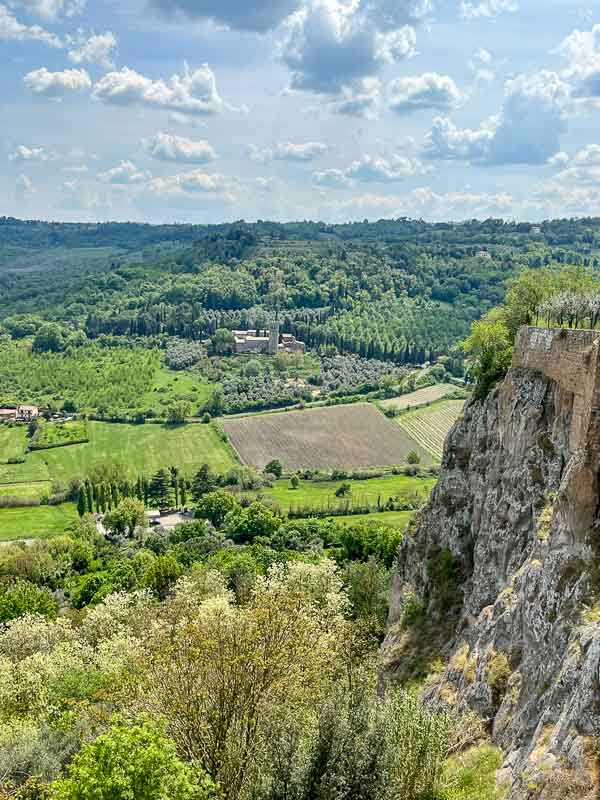
If you want to get the lay of the land, walk The Rupe.
This peaceful path circles the town at the base of the cliff on which it perches. There are five access points from town for the 3-mile circuit and the signposted walk includes sightseeing points, including the Etruscan Necropolis.
The undulating path includes some steep inclines and there is not much shade. Wear sunscreen and a hat.
Make sure you pick up the hugely helpful map from the Tourist Information Office which highlights the route.
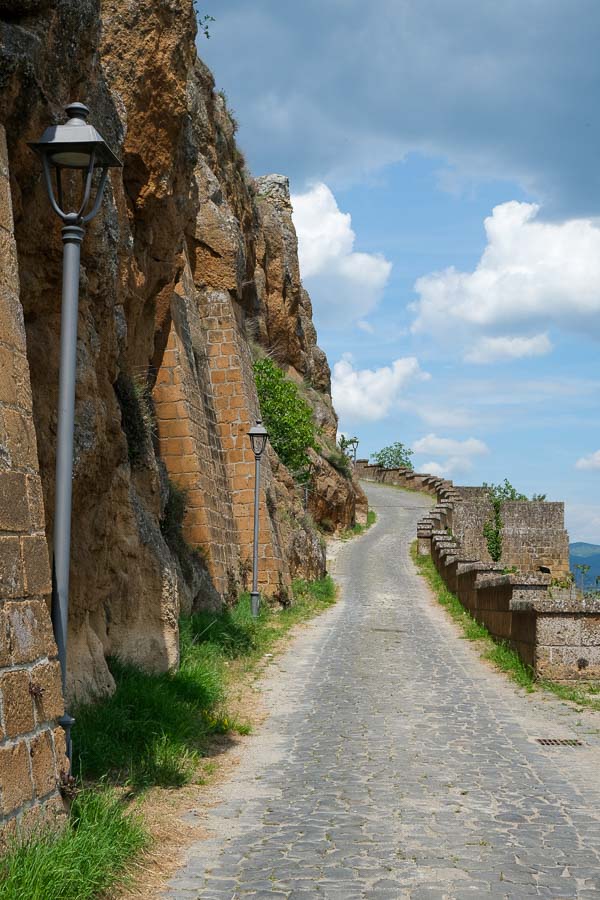
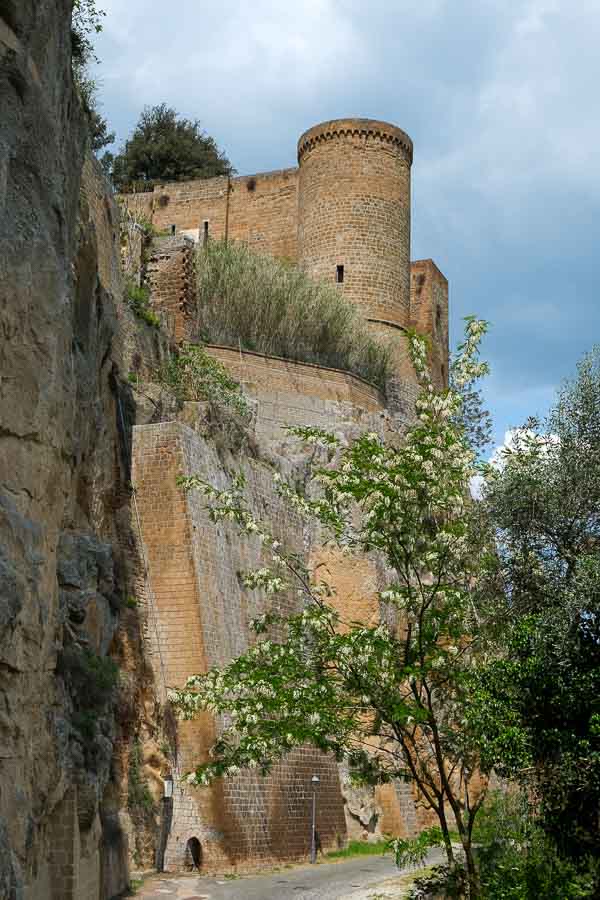
For the most part, the path is good. On one side, Orvieto rises above you; the Umbrian countryside is to the other side.
It’s a wonderful walk but one for daylight hours only (especially if you are a solo traveller).
14. The view from Parcheggio Duomo Orvietto
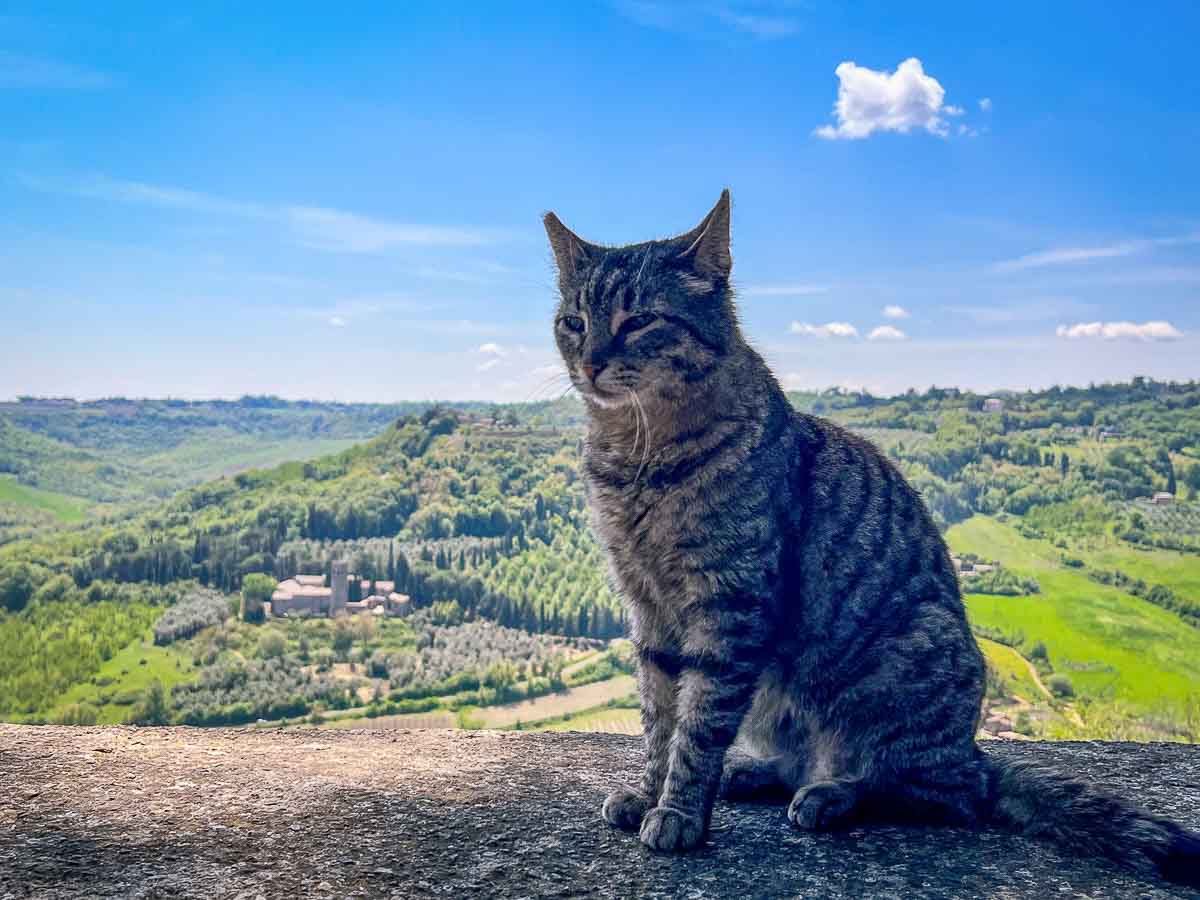
One of the best viewpoints in Orvieto is that from the car park for the cathedral, close to the entrance to Orvieto Underground. If you’re lucky, a local cat will happily pose for you.
15. Albornoz Fortress and Gate (Fortezza Albornoz e Porta Rocca)
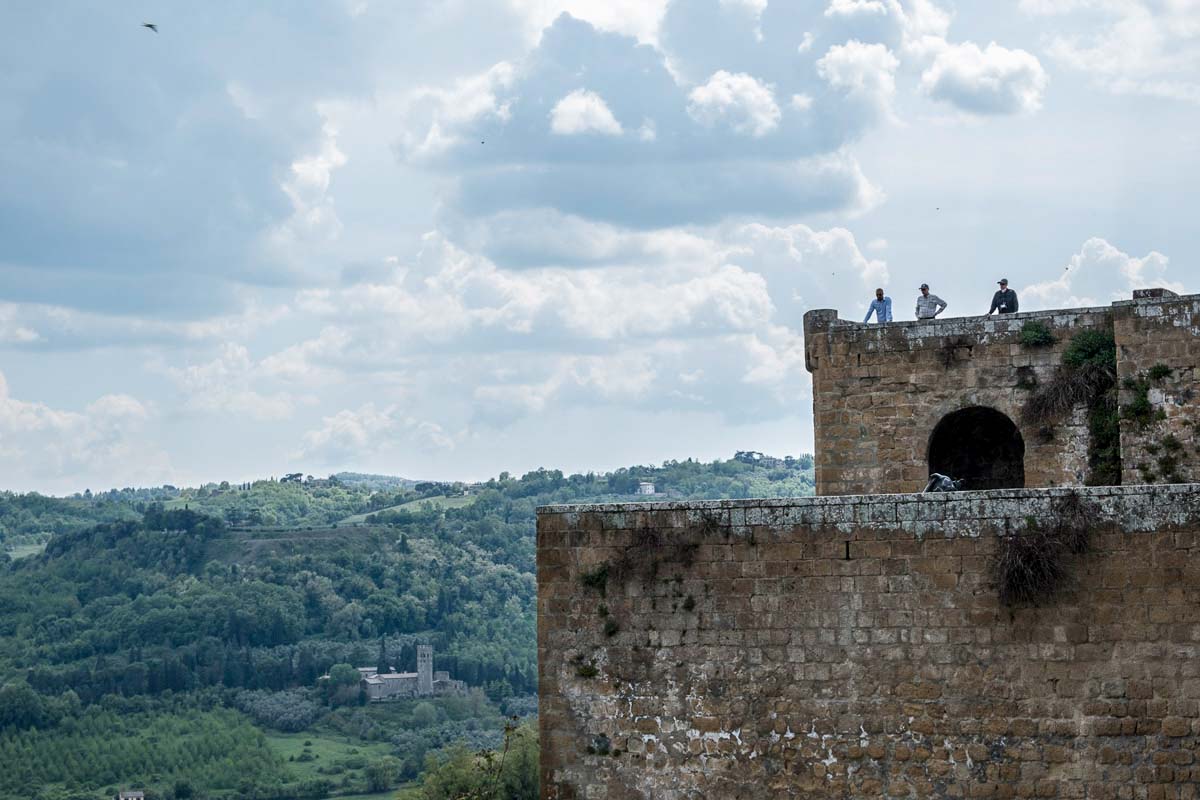
Next to the funicular station is this imposing fortress, originally commissioned by Cardinal Egidio Albornoz in 1364. However, the structure we see today is the result of rebuilding in 1450 under the control of the Papal State.
Today, the Albornoz Fortress has a lovely public garden and panoramic views over the Valley of Orvieto below. It also houses the birthplace of Luigi Barzini, a famous writer and journalist of Orvieto.
Entrance is free
16. Go wine-tasting
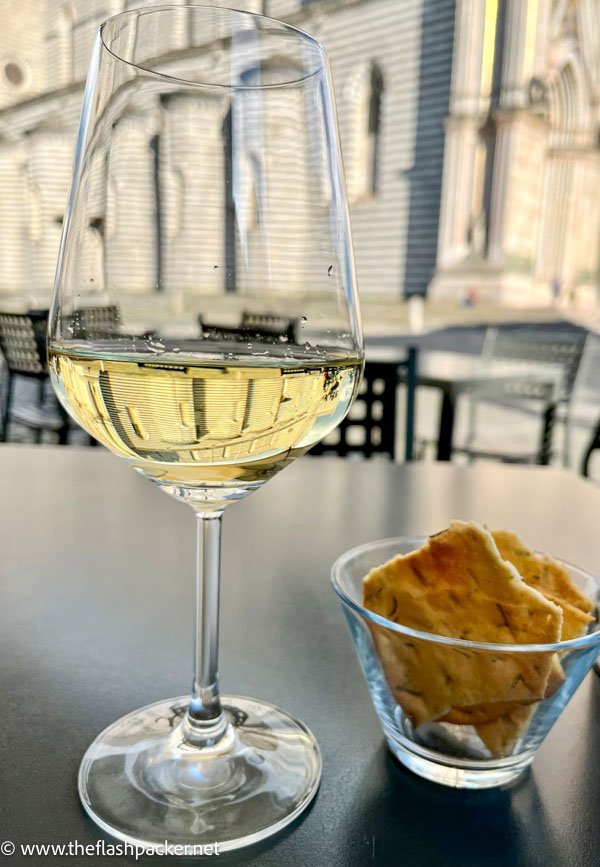
If you like white wine you’ve come to the right place. One of the fun things to do in Orvieto is to sample the local wine.
Orvieto Classico wine is famous for a reason. Soft and dry with delicate flavours of citrus and ripe pear, an Orvieto Classico Bianco must be made from at least 60 percent local Grechetto and/or Trebbiano grape varieties.
In town, Enoteca La Loggia on Corso Cavour offers wine tastings. But you can do far worse than sipping a glass of Orvieto Classico as the sun sets over the cathedral.
17. Shop for ceramics
When it comes to shopping in Orvieto, it’s all about pottery.
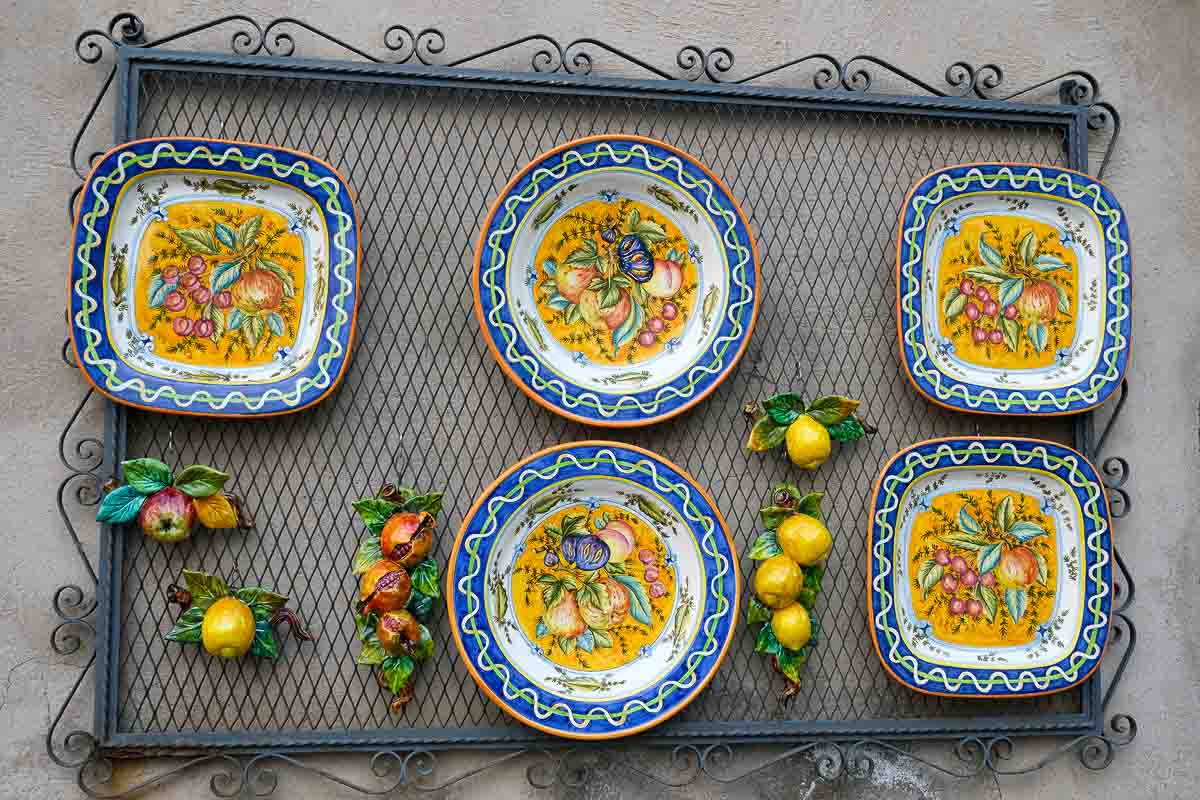
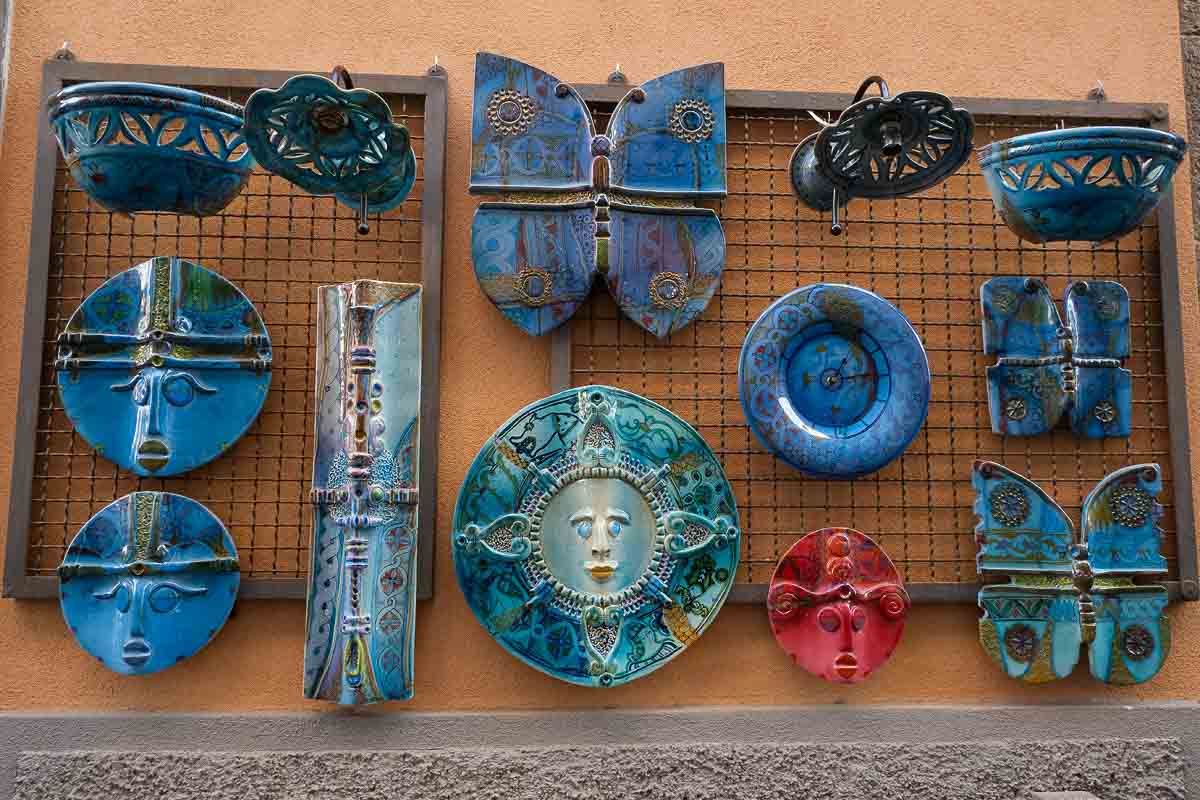
The town’s ceramics trade started with the Etruscans but grew in prominence during Orvieto’s heyday in the 13th Century. This fine tradition has been upheld and the shops that line its streets sell the town’s distinctive ceramic goods.
18. Have a night out at Teatro Mancinelli
If possible, try to catch a performance at Orvieto’s beautiful Neoclassical theatre. It has an active programme, hosting both national and international performers.
You can check the latest news from Teatro Mancinelli here.
19. Try the local cuisine
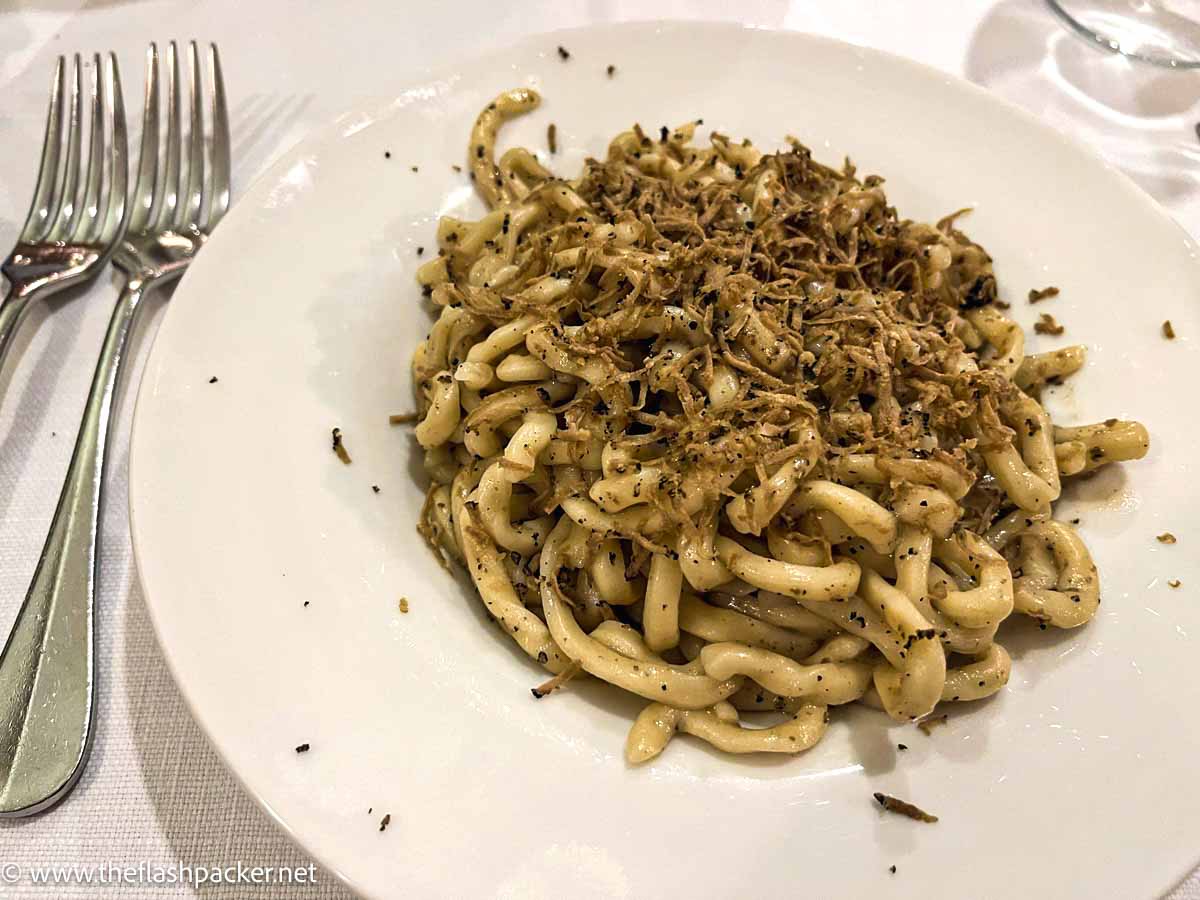
In terms of places to eat, Orvieto punches way above its weight.
Try typical Umbrian dishes such as wild boar (cinghiale), black truffles (tartufo nero), pigeon and umbricelli (a thicker and chewier version of spaghetti). Washed down with a glass or two Orvieto Classico of course.
20. Explore the streets of Orvieto
Like many Italian towns, much of the joy in visiting Orvieto lies in simply wandering its streets. This may sound a bit lame, but this is one picturesque town.
Stuff the map inside your bag and go where your feet take you. You won’t regret it.
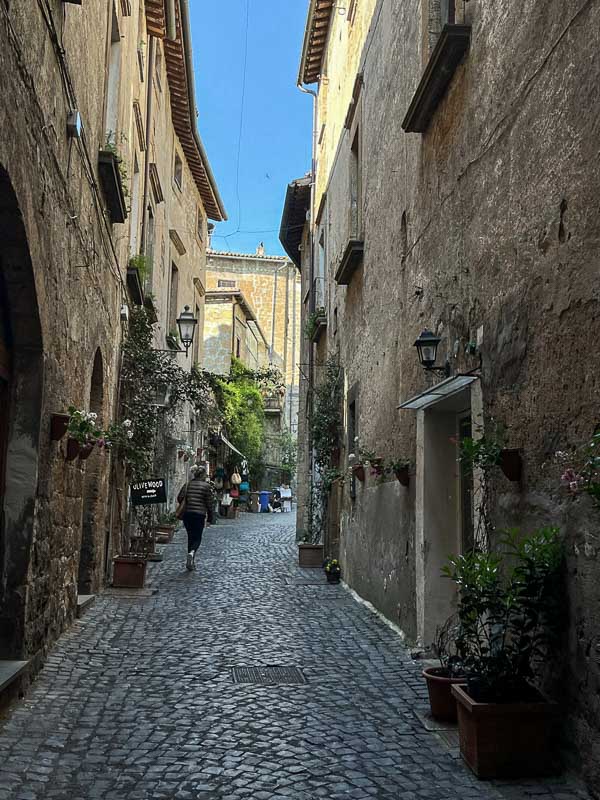
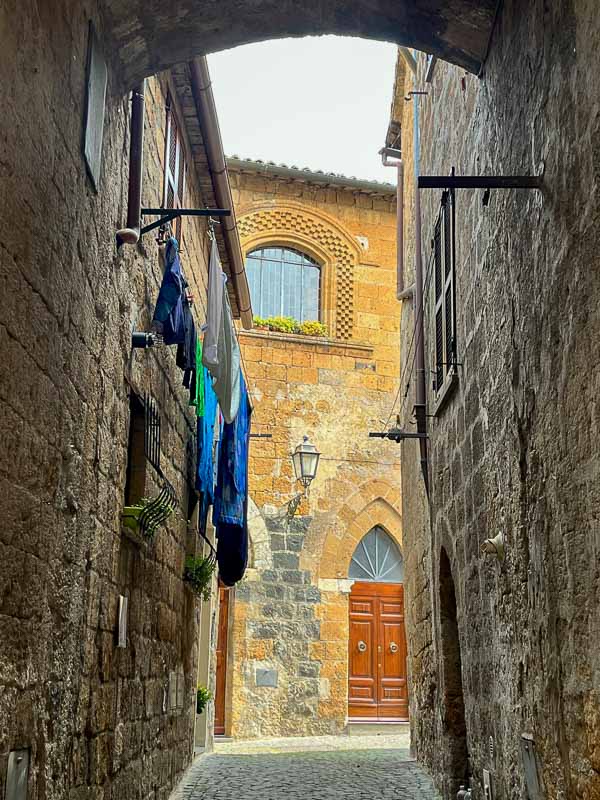
The Orvieto City Card (Orvieto Carta Unica)
Buying the Orvieto City Card (Orvieto Carta Unica) can save you money. In 2024, it costs €25 which gives you free admission to these nine sites.
- Orvieto Cathedral
- MoDo Museum
- National Archaeological Museum
- Faina Etruscan Museum
- Necropolis of the Crocifisso del Tufo
- Orvieto Underground
- Well of the Cava
- St. Patrick’s Well
- Torre del Moro
I bought this card and maxed it out, saving €14 in admission fees. Like any city card, you will need to do the maths to see if it will be worth it, based on what you plan to see in Orvieto.
Other discounts are also available
You can buy your Orvieto Carta Unica online here or from any of the participating sites. The Card is valid for 1 year from the time you enter the first site.
Themed city cards – Piazza Duomo, Medieval, Subterranean and Etruscan – are also available for €15.
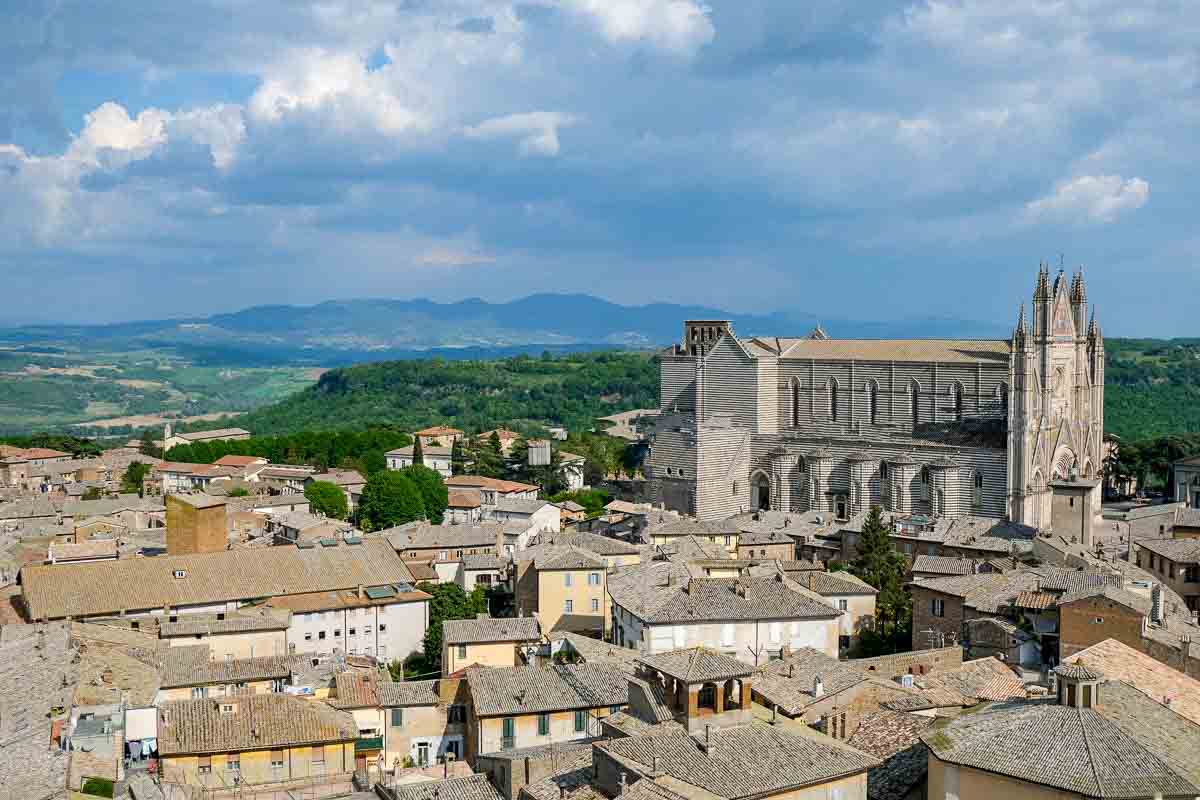
When to Visit Orvieto
For warm weather and little chance of rain, visit Orvieto between April and October. For me, the best months are May / June and September / October, when the temperature is balmy but doesn’t reach the sizzling heights of July and August.
How Much Time Do You Need in Orvieto?
With a little forward planning, you can see most of Orvieto in one day. For this reason, Orvieto is a popular day trip from Rome.
However, stay overnight if possible. This will allow you to enjoy its ancient streets when they have emptied of day trippers, relax over a meal in one of the town’s excellent restaurants and visit the unforgettable Civita di Bagnoregio.
Getting There
Orvieto is in southwestern Umbria, in the province of Terni. It is located between Rome and Florence, making it an easy day trip from either city (or a stop if you are travelling between Florence and Rome).
By train
Using Trenitalia, Orvieto is an easy train journey from Rome (1 hour 15 minutes) and Florence (from 2 hours). Trains services operated by Italo do not stop at Orvieto.
Orvieto is made up of two parts: Orvieto Centro (its historical centre located high up on the rock) and Orvieto Scalo which is at the foot of the rock.
The railway train station is located in Orvieto Scalo.
To reach the historic centre, take the funicular. The funicular station is opposite the train station and the service runs every 10 minutes from 7:15 am to 8:30 pm (from 8 am on holidays). Buy your ticket from the train station’s Buffet della Stazione.
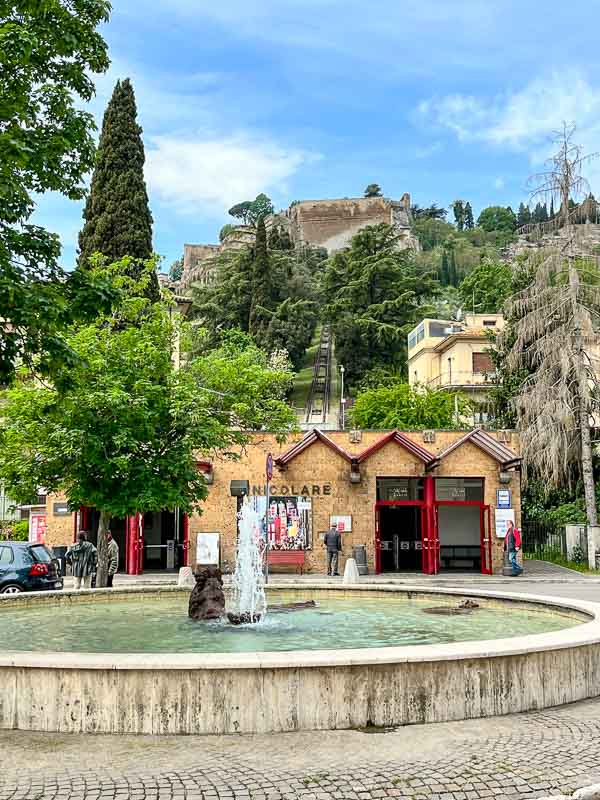
When you alight in Piazza Cahen in Orvieto Centro, it’s a 15-minute walk to the Duomo. Alternatively, your funicular ticket includes the free shuttle bus to Piazza Duomo.
By car
Orvieto makes a great stop-off between Florence and Rome if you are visiting Italy on a road trip.
Much of the historic centre is a limited traffic zone (called locally ZTL) or pedestrian-only. When you arrive in Orvieto, the easiest thing to do is to sling your vehicle in one of the city’s parking lots.
There are three main car parks in Orvieto:
- Piazza della Pace in Orvieto Scalo (also known as parcheggio della funicolare) – free. This is the best option in high season.
- Via Roma in the city centre – paid
- Campo della Fiera in the city centre – paid
On an organised tour
If you want someone else to take care of all of the arrangements for you and want to benefit from the knowledge of a local guide, consider joining an organised tour to Orvieto. Day tours are also great for meeting other people if you are a solo traveller.
Orvieto & Civita di Bagnoregio from Rome
This affordable day tour also includes a visit to Civita di Bagnoregio, one of the most enchanting places in Italy and not to be missed if you are in the Orvieto region. Lunch is also included.
>>> CLICK HERE TO BOOK
Orvieto and Assisi Day Trip from Rome
Assisi is another of my favourite places in Italy and is the perfect partner for Orvieto on this day trip from Rome. Again, this is a good value excursion and lunch is provided.
>>> CLICK HERE TO BOOK
Getting Around
Orvieto is so small that the only public transport you will need is the funicular if you are arriving by train. Walking from one end of the historic centre to the other will take you no more than 30 minutes.
Where to Eat in Orvieto
Your stomach will thank you when you visit Orvieto. Here are a few restaurants that I tried and recommend:
Trattoria La Palomba
My pasta with shaved truffles followed by lamb was the best meal of this trip to Italy. This family-run restaurant has been around for 50 years and specialises in local dishes.
Book ahead.
Address: Via Cipriano Manente, 16, 05018 Orvieto
Febo (FE3.0)
For a break from Orvieto Classico, try this microbrewery. Although, as a solo diner, I found the service to be indifferent, the food was good and the beer excellent.
Address: Via Gualverio Michelangeli, 7, 05018 Orvieto
Where to Stay in Orvieto
Unless you are travelling on a budget or there is no more room at the inn, don’t stay in Orvieto Scalo. Instead, head up the hill to the historic centre. Most of the choices are self-catering apartments.
Sadly, the lovely apartment in which I stayed – Domus Etrusca – is now closed for business, but here are a few highly-rated places I recommend.
Guest House – Casa Vèra Affittacamere
Located on a quiet lane, just a few steps from the Cathedral, this guest house has garnered many excellent reviews. The double room has a private terrace.
>>> CLICK HERE FOR INFORMATION & TO BOOK
Hotel – Hotel Palazzo Piccolomini
Housed in a restored medieval building in the heart of Orvieto, this 4-star hotel is a 5-minute walk from the Cathedral.
>>> CLICK HERE FOR INFORMATION & TO BOOK
Hotel – Hotel Duomo
The rooms in this modern hotel, tucked in a side street off Piazza del Duomo, have double glazing to muffle the sound of those church bells. Some of its rooms are Duomo-facing.
>>> CLICK HERE FOR INFORMATION & TO BOOK
>>> None of these places take your fancy? Search for other great places to stay in Orvieto here.
Why I Think That Orvieto is Worth Visiting
With a rich history stretching back to Etruscan times, one of the most spectacular cathedrals in Italy, beautiful views over the Umbrian landscape and charming streets, Orvieto is a wonderful addition to your Italy itinerary. With its friendly and relaxed vibe, it is also a great Italian destination if you are travelling alone.
Visit Orvieto for the day for its clutch of fascinating sights; stay overnight to experience its blissfully uncrowded streets and eat some of the best food in Italy.

About Bridget
Bridget Coleman has been a passionate traveller for more than 30 years. She has visited 70+ countries, most as a solo traveller.
Articles on this site reflect her first-hand experiences.
To get in touch, email her at hello@theflashpacker.net or follow her on social media.

